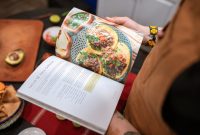
As culinary enthusiasts and seasoned cooks know, mastering the art of roasting a ribeye to perfection is both a science and an art form. The ribeye roast, known for its rich flavor and marbling, can be the centerpiece of any celebratory meal, provided it is cooked to the right internal temperature. In this guide, we explore the best practices for achieving the ideal ribeye roast, diving into the specifics of optimal beef cooking internal temperatures as they are recommended in 2025.
Understanding the Ribeye Roast
The ribeye roast, often referred to as a prime rib, is a cut of beef that comes from the rib section. It is prized for its tenderness and rich flavor, thanks to the generous marbling of fat that runs through the meat. Preparing this cut correctly requires attention to detail and a focus on internal cooking temperatures to ensure the meat is not only safe to eat but also retains its juiciness and flavor.
Optimal Internal Temperatures for Ribeye Roast
For those aspiring to cook a ribeye roast to perfection, understanding the nuances of internal temperatures is crucial. The doneness of the beef is often measured by the internal temperature, which varies depending on personal preference for how well-cooked you like your meat.
- Rare: Cook to an internal temperature of 120°F (49°C). This yields a cool to warm red center.
- Medium Rare: Aim for 130°F (54°C). This results in a warm red center, providing a tender and juicy roast.
- Medium: Target 140°F (60°C) for a warm pink center.
- Medium Well: 150°F (66°C) gives a slightly pink center.
- Well Done: Achieve 160°F (71°C) for little to no pink center, ensuring a thoroughly cooked roast.
It’s important to note that the roast should be removed from the oven when it is 5-10 degrees below the target temperature, as carryover cooking will continue to raise the internal temperature as it rests.
Preparing Your Ribeye Roast
The preparation of your ribeye roast is just as important as the cooking process. Start with a well-marbled, high-quality piece of meat. Allow the roast to reach room temperature before cooking, which helps it cook more evenly.
- Season generously with salt, pepper, and any additional herbs or spices you prefer. Common choices include rosemary, thyme, and garlic.
- Consider using a marinade or a dry rub to enhance the flavor further.
- Preheat your oven to 450°F (232°C) for the initial sear, which will help lock in juices and flavor.
Cooking the Perfect Ribeye Roast
Once your roast is prepared, follow these steps to cook it to perfection:
- Searing: Place the roast in the preheated oven to sear for about 20 minutes.
- Reduce Heat: Lower the oven temperature to 325°F (163°C) and continue roasting until the desired internal temperature is reached.
- Resting: After removing the roast from the oven, let it rest for at least 20-30 minutes. This allows the juices to redistribute, ensuring a juicy and tender result.
Tips for Monitoring Internal Temperature
Using a reliable meat thermometer is essential for monitoring the internal temperature accurately. Consider these tips:
- Insert the thermometer into the thickest part of the roast without touching bone or fat.
- Use a thermometer with a probe for continuous monitoring.
- Calibrate your thermometer regularly for accurate readings.
Accompaniments and Serving Suggestions
Pair your ribeye roast with classic sides such as garlic mashed potatoes, roasted vegetables, or a fresh green salad. A robust red wine, like a Cabernet Sauvignon or a Malbec, complements the rich flavors of the beef beautifully.
FAQ
Q: How long should I cook a ribeye roast per pound?
A: Typically, cook a ribeye roast at 325°F (163°C) for about 15-20 minutes per pound, depending on your desired level of doneness.
Q: Should I cover my ribeye roast while it cooks?
A: It is generally recommended to cook the roast uncovered to ensure a crisp, browned exterior.
Q: Can I cook a ribeye roast from frozen?
A: It is best to thaw the roast in the refrigerator before cooking to ensure even cooking throughout.
Q: How can I add extra flavor to my ribeye roast?
A: Using a marinade, dry rub, or stuffing the roast with garlic and herbs can enhance its flavor.
Q: What’s the best way to carve a ribeye roast?
A: Use a sharp carving knife to slice across the grain, ensuring each slice is tender.
Conclusion
Mastering the perfect ribeye roast involves understanding the importance of internal temperature, preparation, and cooking technique. By paying attention to these details, you can ensure your roast is not only safe to eat but also bursting with flavor and juiciness. Whether you’re hosting a holiday gathering or a special occasion, a well-cooked ribeye roast is sure to impress your guests and provide a memorable dining experience.


